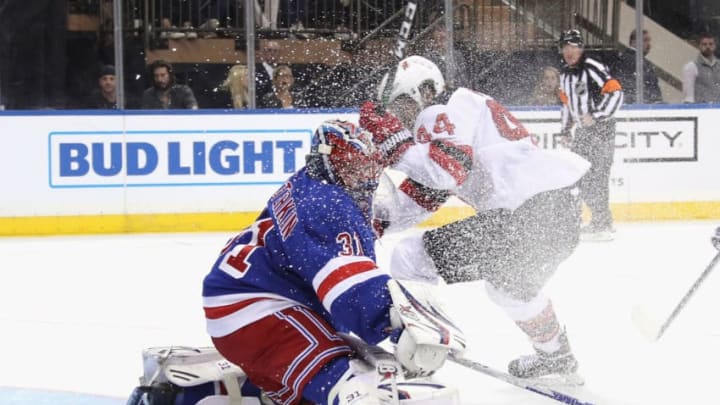
Pros and cons
In mid-December we did a pros and cons article about the three goalie system. We are revisiting those arguments with some modifications based on what has happened over the last month.
At the time we made the argument that the Rangers needed to get Shesterkin up to the NHL sooner than later due to his European Assignment Clause and also that his Entry Level Contract was for only two years and expires after next season. It was also before Georgiev had made enough appearances to require waivers to be demoted.
We should also put to bed any question about the Seattle expansion draft. Shesterkin is exempt and Lundqvist will be a free agent so they would only need to protect Georgiev.
Let’s look at the options we presented in December for a three goalie system next season:
Positives
Pro # 1It sure looks like the Rangers have two young stud goaltenders in Alexandar Georgiev and Igor Shesterkin. They also have 37-year old Henrik Lundqvist under contract for one more year after this one. That’s precisely why this could work, they would only have to do it for one year. A single year with a three goalie system and then the team could move forward with a tandem that would arguably be one of the best in the NHL.
Pro # 2
While it looks like both Shesterkin and Georgiev are stud goaltenders, Georgiev has played all of 63 games in the NHL and Shesterkin hasn’t played in one yet. Can anyone honestly say that Shesterkin is going to be a better goalie than Georgiev in the long run? If the trade scenarios are to be believed, the Rangers will have to gamble on one of these two young men in order to keep the two goalie system intact next season. Keep three goalies and a trade isn’t necessary.
Pro # 3
In an 82 game season, would it be so bad to give a 38-year old Henrik Lundqvist twenty starts leaving 62 games for the Georgiev-Shesterkin tandem? Lundqvist has shown that he can excel with a lighter workload. It would give him a decent number of starts in what would be his last season in New York. After the 2020-21 season he would have to decide if he wants to play elsewhere since he would have no future in New York.
Pro # 4
A three goalie system would give Lundqvist the chance to mentor and work with both Georgiev and Shesterkin and they would have a chance to learn from him. Exposing the two young goalies to his work ethic and dedication would be a good thing for their development.
Pro # 5
Protection against injury is important. If any one of the three netminders goes down with an injury, they would have depth in goal that would compete with any team in the NHL.
Negatives
Con #1
It hasn’t worked before and why would anyone expect a three goalie system to work for the Rangers. The most recent example was the two seasons that the Islanders went with Jaroslav Halak, J.F. Berube and Thomas Greiss. Halak went along with it for over one season before he went public with his displeasure and he was traded. The difference here is that with the Rangers we are talking about one veteran and two young goalies, a little different from the Islanders. Let’s not forget that the Islanders front office was a walking disaster area as well.
Con # 2
Another reason a three goalie system doesn’t work is that it doesn’t give any of the three enough work. Georgiev started 30 games last season for the Rangers and it felt like he hardly played. Imagine that scenario for both Georgiev and Shesterkin.
Con # 3
The most compelling reason to go with a two goalie system next season is the opportunity to deal one of their young goalies at the deadline or this summer. If the Rangers can extract a top draft pick or prospect for Georgiev, shouldn’t they do it?
Con # 4
By keeping three goalies it automatically ends Henrik Lundqvist’s Ranger career after next season. This year he has demonstrated that he is still one of the better goalies in the NHL, though no longer elite. In other words, he is a perfect back up. What if Lundqvist agreed to a new contract after next season for reasonable terms so he could end his career as a Ranger? A Shesterkin-Lundqvist or a Georgiev-Lundqvist tandem for the next two or three years could look pretty attractive.
Con # 5
This is the tough one. Why go with a three goalie system if one of those goalies can’t cut it anymore? A number of observers think that Henrik Lundqvist’s best days are behind him and the team should move on. That means buying him out after this season. A buyout would save the team $3 million in cap space in 2020-21, money they desperately need. It would add $1.5 million to the cap hit in 2021-22, but that would be year that they are free of the $10 million they are paying Marc Staal and Brendan Smith so they could afford it. Is that really an option?
This was our conclusion in December:
"“Without the waiver exemption, Georgiev isn’t going anywhere so it looks like we may actually see a three-headed goalie monster on the Rangers roster before this season is over if the team bring Shesterkin up. If that happens, it could be a precursor of a roster option for the Rangers next season. Tough decisions loom.”"
Tough decisions indeed. And the Rangers made the toughest one when they decided to promote Shesterkin. If he is everything we think he is, David Quinn’s job just got that much harder.
And how did Quinn respond to that? He said “It’ll be a challenge for sure, but we’ll manage.”
